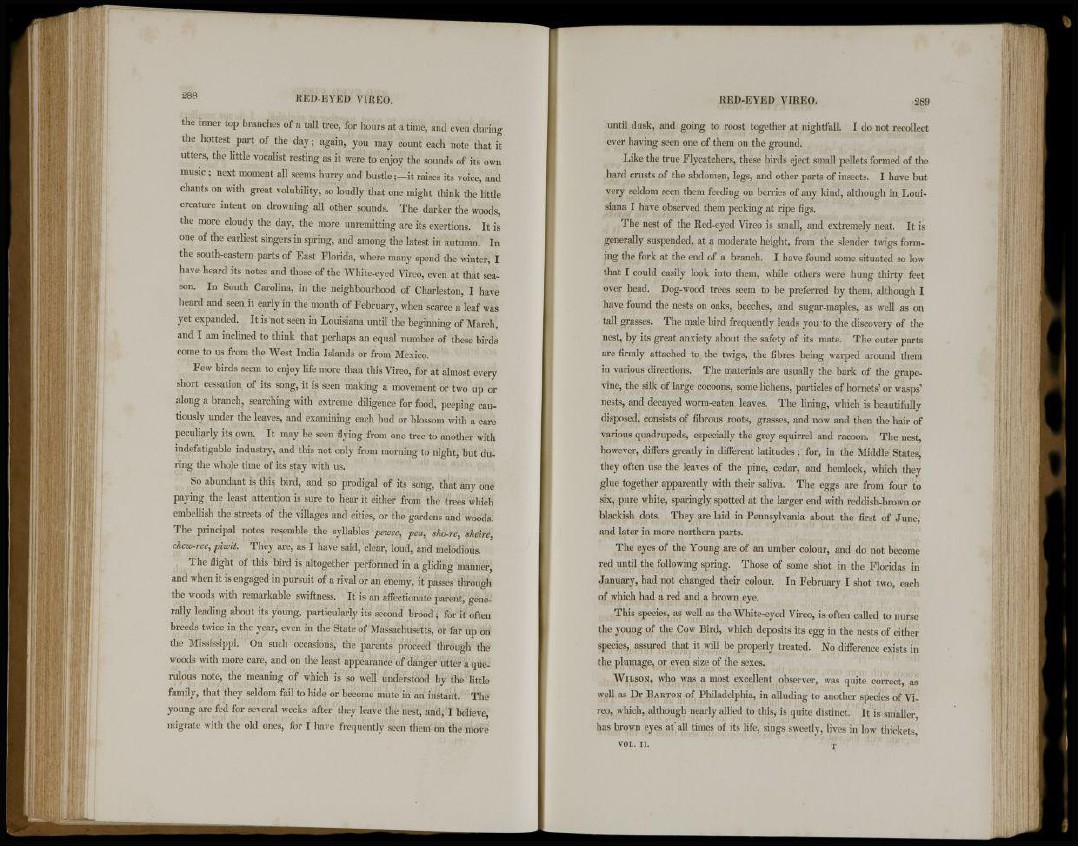
until dusk, and going to roost together at nightfall. I do not recollect
ever having seen one of them on the ground.
Like the true Flycatchers, these birds eject small pellets formed of the
hard crusts of the abdomen, legs, and other parts of insects. I have but
very seldom seen them feeding on berries of any kind, although in. Louisiana
I have observed them pecking at ripe figs.
The nest of the Red-eyed Vireo is small, and extremely neat. It is
generally suspended, at a moderate height, from the slender twigs forming
the fork at the end of a branch. I have found some situated so low
that I could easily look into them, while others were hung thirty feet
over head. Dog-wood trees seem to be preferred by them, although I
have found the nests on oaks, beeches, and sugar-maples, as well as on
tall grasses. The male bird frequently leads you to the discovery of the
nest, by its great anxiety about the safety of its mate. The outer parts
are firmly attached to the twigs, the fibres being warped around them
in various directions. The materials are usually the bark of the grapevine,
the silk of large cocoons, some lichens, particles of hornets1 or wasps'
nests, and decayed worm-eaten leaves. The lining, which is beautifully
disposed, consists of fibrous roots, grasses, and now and then the hair of
various quadrupeds, especially the grey squirrel and racoon. The nest,
however, differs greatly in different latitudes ; for, in the Middle States,
they often use the leaves of the pine, cedar, and hemlock, which they
glue together apparently with their saliva. The eggs are from four to
six, pure white, sparingly spotted at the larger end with reddish-brown or
blackish dots. They are laid in Pennsylvania about the first of June,
and later in more northern parts.
The eyes of the Young are of an umber colour, and do not become
red until the following spring. Those of some shot in the Floridas in
January, had not changed their colour. In February I shot two, each
of which had a red and a brown eye.
This species, as well as the White-eyed Vireo, is often called to nurse
the young of the Cow Bird, which deposits its egg in the nests of either
species, assured that it will be properly treated. No difference exists in
the plumage, or even size of the sexes.
WILSON, who was a most excellent observer, was quite correct, as
well as Dr BARTON of Philadelphia, in alluding to another species of Vireo,
which, although nearly allied to this, is quite distinct. It is smaller,
has brown eyes at'all times of its life, sings sweetly, lives in low thickets,
VOL. II. r
the inner top branches of a tall tree, for hours at a time, and even during
the hottest part of the day; again, you may count each note that it
utters, the little vocalist resting as it were to enjoy the sounds of its own
music ; next moment all seems hurry and bustle;—it raises its voice, and
chants on with great volubility, so loudly that one might think the little
creature intent on drowning all other sounds. The darker the woods,
the more cloudy the day, the more unremitting are its exertions. It is
one of the earliest singers in spring, and among the latest in autumn. In
the south-eastern parts of East Florida, where many spend the winter, I
have heard its notes and those of the White-eyed Vireo, even at that season.
In South Carolina, in the neighbourhood of Charleston, I have
heard and seen it early in the month of February, when scarce a leaf was
yet expanded. It is not seen in Louisiana until the beginning of March,
and I am inclined to think that perhaps an equal number of these birds
come to us from the West India Islands or from Mexico.
Few birds seem to enjoy life more than this Vireo, for at almost every
short cessation of its song, it is seen making a movement or two up or
along a branch, searching with extreme diligence for food, peeping cautiously
under the leaves, and examining each bud or blossom with a care
peculiarly its own. It may be seen flying from one tree to another with
indefatigable industry, and this not only from morning to night, but during
the whole time of its stay with us.
So abundant is this bird, and so prodigal of its song, that any one
paying the least attention is sure to hear it either from the trees which
embellish the streets of the villages and cities, or the gardens and woods.
The principal notes resemble the syllables pezoee, pea, sho-re, sheire,
chezv-ree, p'vwit. They are, as I have said, clear, loud, and melodious.
The flight of this bird is altogether performed in a gliding manner,
and when it is engaged in pursuit of a rival or an enemy, it passes through
the woods with remarkable swiftness. It is an affectionate parent, generally
leading about its young, particularly its second brood; for it often
breeds twice in the year, even in the State of Massachusetts, or far up on
the Mississippi. On such occasions, the parents proceed through the
woods with more care, and on the least appearance of danger utter a querulous
note, the meaning of which is so well understood by the little
family, that they seldom fail to hide or become mute in an instant. The
young are fed for several weeks after they leave the nest, and, I believe,
migrate with the old ones, for I have frequently seen them on the move